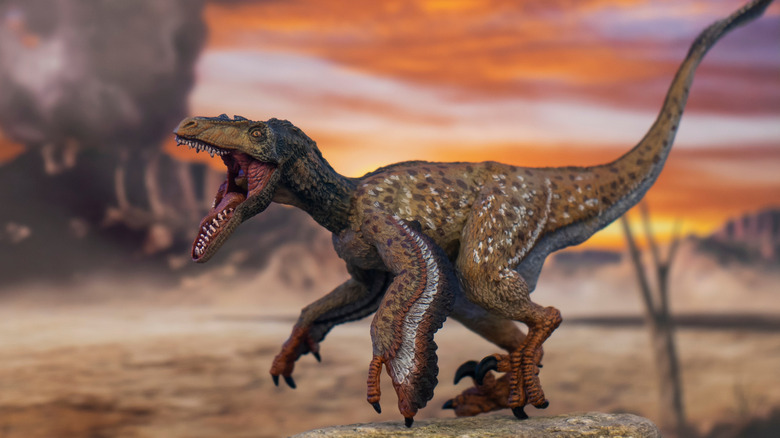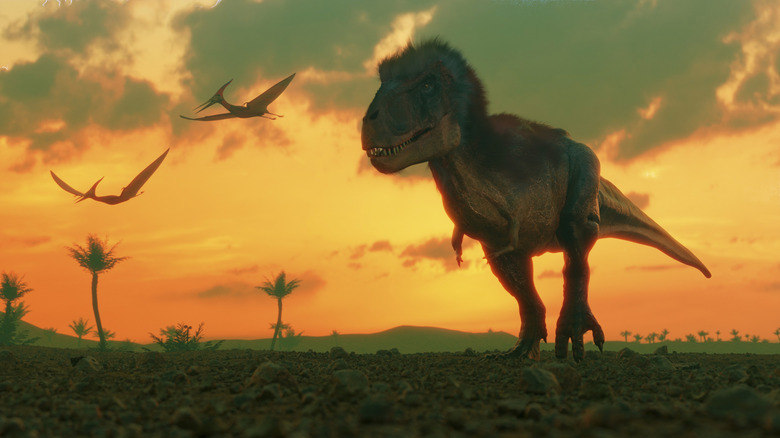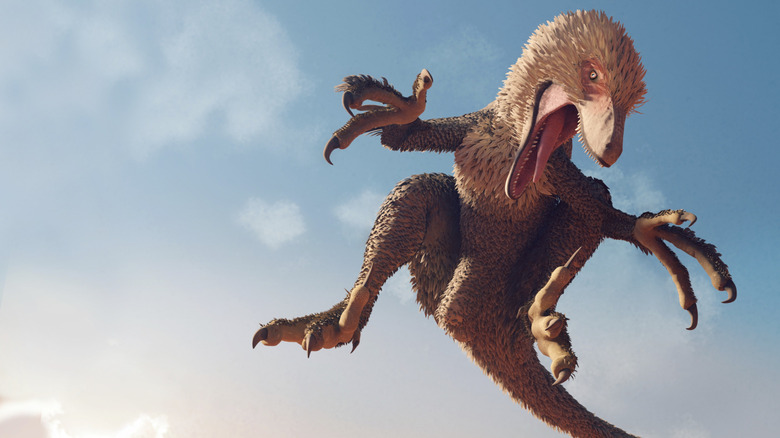What Did Dinosaur Feathers Really Look Like?
If you happened to grow up in the '90s or early 2000s and, like so many kids, had a love for dinosaurs, you might want to take a quick look at what those dinosaurs look like now. These prehistoric creatures have been extinct for 66 million years, but there have been some big recent prehistoric discoveries which have changed our ideas about how dinosaurs really looked — making many seem unrecognizable from the reptilian creatures many of us remember from our childhoods.
In fact, rather than the lizard-like creatures we grew up with, many dinosaurs were covered in feathers, or at least had patches of plumage. But before you start imagining the T. rex trying to masquerade as a chicken, keep in mind that research says dino feathers didn't look quite the same as modern bird feathers. Rather, they were a lot simpler — more like fine thread than the graceful feathers you'd find on birds now.
On the whole, the way we've been picturing dinosaurs is pretty far from reality. The truth about what velociraptors looked like, for example, might shock you — especially if you grew up with Steven Spielberg's seminal "Jurassic Park" as a reference point. Likewise, the T. rex sounded a lot more terrifying than you thought, emitting a low-frequency growl that is infinitely more upsetting than the titanic roar from Spielberg's action adventure classic. Dinosaur feathers are one of the more obvious examples of how our concept of dinosaur physiognomy has changed, though the research has come quite a long way.
Dinosaur feathers are a relatively recent discovery
Back in the 1990s, paleontologists working in China discovered exquisitely preserved specimens of dinosaurs from the early Cretaceous period. These fossils confirmed that certain theropod dinosaurs had feathers, upending experts' understanding of bird evolution and demonstrating that feathers appeared long before birds or flight. Despite all the progress we've made in understanding dinosaur feathers, however, many questions remain unanswered, including how common these feathers and feather-like structures were and how many groups of dinos had them. We also are yet to determine whether feathers were more widespread among reptile species and whether feathers originated with Theropoda, a particular clade of dinosaurs, or with Avemetatarsalia, a clade of diapsid reptiles that includes all dinosaurs and pterosaurs. Even with all these unanswered questions, however, we do have some fascinating insights into what dinosaur feathers might have looked like.
Today, bird feathers are all composed of the protein beta-keratin. A central shaft, known as the calamusrachis, is held inside the feather follicle. It then extends upward, becoming what's known as the rachis. It's from this rachis that branches extend outward into barbs, from which smaller barbules with a hooked appearance extend. Taken as a whole, these branches form what's known as the vane. There are, of course, a diverse array of feathers, with some examples lacking the hooked barbules, but this basic structure remains consistent among bird species. The feathers found on dinosaurs, however, likely looked a lot different.
Dinosaur feathers looked very different compared to modern bird feathers
In a 2025 paper published in Biology Letters, Paul Barrett and Xu Xing explore the current knowledge of dinosaur feathers, noting how early feathers were different from their modern-day equivalents in terms of their morphology, structure, and biochemistry. The fossil record reveals that the feather-like structures found on theropods — dinosaurs that walked on two legs — were much simpler than the feather structures we see in birds today. These early feathers were filamentous, or thread-like, and didn't have the branching structure of their modern-day counterparts.
A 2012 study published in Evolution detailed the discovery of a Sciurumimus fossil — one of the earliest theropods from around 150 million years ago — which revealed much about these early "protofeathers." The researchers described long, very fine hair-like filaments on the tail of the fossil which appeared to have been anchored in the skin. These early examples of feathers are monofilaments, which means that the researchers didn't observe any of the branching structures seen in modern bird feathers.
As dinosaurs evolved, more advanced feathers emerged, with branched feathers identified in Dilong (a theropod from between 128 million to 127 million years ago) and Sinosauropteryx, which existed roughly 125 million years ago. That said, some dinosaurs appear to have developed feathers more akin to those found on modern day birds. Pennaceous feathers — a type of feather found on most modern birds which have small interlocking barbules — have been identified at the bases of Pennaraptora (a clade of theropods that emerged in the late Jurassic period, roughly 161.5 million to 145 million years ago.)
On the whole, however, feathers seem to have evolved from thread-like filament structures into more complex branched feathers. Branched feathers with a rachis then emerged, before leading to pennaceous feathers that more closely resemble those found on birds.


